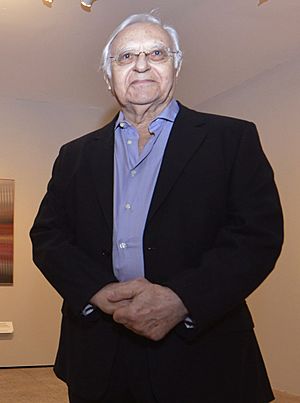Abraham Palatnik facts for kids
Quick facts for kids
Abraham Palatnik
|
|
|---|---|
 |
|
| Born | February 2, 1928 |
| Died | May 9, 2020 (aged 92) Rio de Janeiro, Rio de Janeiro, Brazil
|
| Style | Kinechromatic art |
Abraham Palatnik (born February 2, 1928 – died May 9, 2020) was a Brazilian abstract artist and inventor. He is famous for creating a new type of art called kinechromatic art.
About Abraham Palatnik's Life
Abraham Palatnik was born in Natal, Rio Grande do Norte, Brazil. When he was four years old, in 1932, his family moved to Israel. He lived there until 1947. His parents were Jewish immigrants from Ukraine.
While in Israel, he studied at the Montefiori Technical School in Tel Aviv from 1942 to 1945. He also took art classes at the Municipal Art Institute of Tel Aviv. He learned about mechanics, physics, and drawing during this time.
In 1948, Palatnik returned to Brazil and settled in Rio de Janeiro. He became friends with an art critic named Mario Pedrosa. He also visited the Pedro II National Psychiatric Center. There, he saw how patients used art in therapy, which changed his ideas about art.
Palatnik is known as a pioneer in Brazil for using technology in his art. He was one of the first to use mechanical systems and light in his artworks. He showed some of his pieces at the First Biennial of São Paulo in 1951.
Two of Palatnik's artworks are part of the collection at the Museum of Modern Art in New York. In 2013, one of his works, "Sequencia Visual S-51," sold for a large amount of money. This shows how important his art is.
Cinechromatic Art: Light and Movement
One of Abraham Palatnik's most important inventions is the Cinecromatic Apparatus. This was an artistic machine he created based on his experiments with electricity and mechanics. Its goal was to make kaleidoscope-like images move in a planned way. The art critic Mario Pedrosa gave it the name "cinechromatic."
The Cinecromatic Apparatus was a complex device. It had 600 meters of wires and 101 light bulbs of different brightness. It also used several cylinders that spun at different speeds, powered by motors. A set of prisms, lenses, and shapes helped project light onto a special screen. This screen was made of semi-transparent plastic. The machine would project controlled colors and shapes onto the screen in cycles lasting twenty to thirty minutes.
Palatnik's work, including his paintings and drawings, explored the idea of movement in art. He started these explorations around 1949.
From 1959, he began to create three-dimensional artworks that moved. He made pieces where electromagnetic fields caused small objects inside closed boxes to move. At the same time, he also painted on flat surfaces. In 1962, he started his "Progressões" (Progressions) series. In 1964, he created "Kinetic Objects." These were sculptures made of wire, colored shapes, and moving threads. Motors and electromagnets powered them, making them move like the sculptures of American artist Alexander Calder.
After many experiments with technology, he created his "Aparelhos Cinecromáticos" (Cinecromatic Devices). These were light boxes with moving bulbs that changed color fields under a see-through fabric. He first showed this work at the 1st São Paulo Biennial in 1951.
In 1953, Palatnik helped start the Frente Group in Rio de Janeiro. He and the other members showed their art together in various cities. He continued to design machines that made color appear to move.
His "Aparelhos Cinecromáticos" were also shown at the Venice Biennale in 1964. This exhibition gave him international recognition. He became known as one of the artists who started kinetic art. Because of this, he also took part in the "Mouvement 2" kinetic art exhibition in Paris in 1964.
Death
Abraham Palatnik passed away on May 9, 2020, in Rio de Janeiro. He was 92 years old and died from COVID-19 during the COVID-19 pandemic in Brazil.

